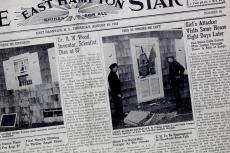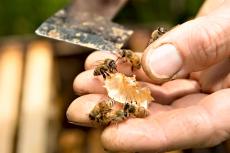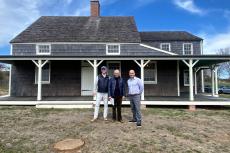The East Hampton Village Board has approved a lease agreement with the East Hampton Historical Society for the Dominy Shops at 73 North Main Street, effective Feb. 1, 2023.
“The village wants to activate the space as a museum, so it’s not just, ‘Hey, that’s a terrific restoration,’ ” said Stephen Long, director of the historical society, in a phone interview this week. “The story of the Dominys and their impact on East Hampton will finally be accessible to visitors.”
That story is well known to readers of The Star. During the late 18th and early 19th centuries, three generations of Dominy men built clocks and furniture from a woodworking shop and a clock shop they had added to the family house. The village of East Hampton owns the very parcel of land where the house and shops once stood, as well as the recently reconstructed buildings themselves.
Speaking at the board meeting, Mr. Long said, “The Dominy family and the work that they did is the glue of East Hampton. Everywhere you look — the furniture in people’s homes, the beams that were used to construct their houses, the windmills that are iconic in East Hampton — all came from the Dominy shops.”
“But there’s quite a lot of work that needs to be done,” cautioned Robert Hefner, a historic preservation consultant and the village’s former director of historic services. Mr. Hefner has been the “leading force” in preserving the little shops, said Mr. Long.
The shops were first moved from the site they now occupy just before the outbreak of World War II, Mr. Hefner recounted, and dismantled. After many twists and turns, and after a stint as “a little clubhouse” on an estate off Further Lane, they were donated back to the village by the Rosenstein family in 2016.
The work of restoration was to be completed in two phases. In phase one, begun in 2018, the framework went up and the exterior was completed.
Phase two “was put out to bid over a year ago” Mr. Hefner said. “That work is to restore the interior of the clock shop, reconstruct the forge and chimney, and put in mechanical systems.”
“The village board has been sort of delaying on accepting the bid,” he added. “I assume that with this lease agreement with the historical society that they may go forward with completing.”
John Hummel and Associates won the contract for phase two and a contract to do the sanitary system is in place. “Everything is all ready to go, and everybody is anxious to start work,” Mr. Hefner said. “Let’s hope that will happen and we can do it this spring and summer.”
“We’re excited about collaborating with the village, having them be a partner,” said Mr. Long. To that end, he announced at the board meeting that Mayor Larsen has been named an “honorary ex-officio trustee” of the historical society’s board.
“Did Tiger actually vote for me?” asked Mayor Larsen, smiling. Arthur (Tiger) Graham is the treasurer of the historical society as well as a village board member, and he and the mayor have not always seen eye to eye.
“In fact, he did!” said Mr. Long.
Once phase two is complete, the space will be ready to open to the public as the village’s newest museum.
“The biggest thing for restoration is the interior of the clock shop. There’s a very significant forge and fireplace in the clock shop,” said Mr. Hefner. Once that’s done, he said, “Everything would be complete, and we have a lot of furniture and tools that have already been donated to this museum.” Finally, it will be up to the historical society to “put together the exhibit and interpretive program and open it up.”
“It’s a very important project and an incredible building that adds so much to the historic character of the village,” Mr. Hefner concluded. “I just want to get it done, so that people can see it. I hope that will happen.”
“It’s going to be a powerful narrative,” said Mr. Long at the meeting. “Such a jewel for this community.”




